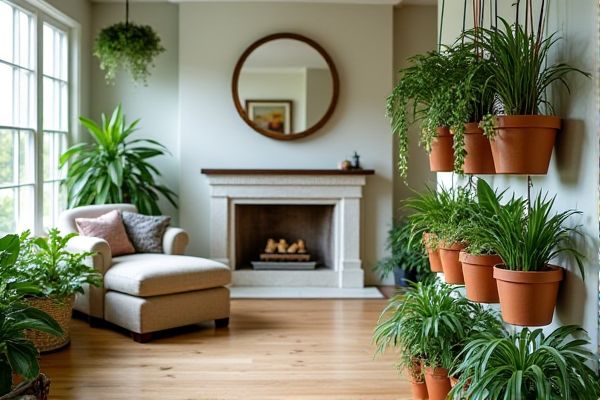
Vertical planters maximize space by allowing you to grow numerous plants upward on walls or structures, making them ideal for small areas or urban gardening. Hanging planters add aesthetic appeal and flexibility for your plants, enabling easy relocation and better light exposure; explore the differences in design and functionality to choose the best option for your garden needs.
Table of Comparison
| Feature | Vertical Planters | Hanging Planters |
|---|---|---|
| Space Efficiency | Maximizes floor and wall space, ideal for small gardens | Saves floor space by utilizing ceiling or wall mounts |
| Plant Types | Suitable for herbs, succulents, and small vegetables | Best for trailing plants, ferns, and flowers |
| Installation | Requires mounting or freestanding setup | Needs secure ceiling hooks or wall brackets |
| Water Drainage | Often built-in or easily managed | May drip; requires drip trays or waterproof areas |
| Accessibility | Easy to reach and maintain at multiple levels | Can be harder to access for watering and pruning |
| Aesthetic | Creates structured, space-saving greenery displays | Provides dynamic, cascading plant visual effects |
| Durability & Material | Commonly made from wood, metal, or plastic | Typically plastic, ceramic, or woven materials |
| Cost | Moderate, depends on size and material | Varies widely, generally affordable |
| Best Use | Urban gardening, balconies, walls | Indoor decoration, patios, shaded areas |
Introduction to Vertical and Hanging Planters
Vertical planters maximize limited space by allowing you to grow plants upward on walls or structures, ideal for urban gardening or small balconies. Hanging planters suspend plants in the air, creating dynamic visual interest while saving floor space and improving air circulation for your greenery. Choosing between vertical and hanging planters depends on your available space, aesthetic preferences, and the types of plants you want to cultivate.
Design and Aesthetic Appeal
Vertical planters maximize space with sleek, structured designs that create a living wall effect, ideal for modern and minimalist interiors. Hanging planters offer a dynamic and airy aesthetic, adding visual interest through suspended greenery that softens room corners or outdoor patios. Both styles enhance ambiance by integrating nature, but vertical planters emphasize architectural elegance while hanging planters focus on organic flow and movement.
Space Efficiency and Placement Options
Vertical planters maximize space efficiency by utilizing wall surfaces and narrow areas, making them ideal for small patios or urban gardens, whereas hanging planters save floor space by suspending plants from ceilings or structures, allowing for creative layering. Vertical planters offer stable placement along walls or fences, providing a structured and accessible growing area, while hanging planters enable dynamic placement options such as balconies, pergolas, or indoor spaces with overhead support. Choosing between the two depends on available space height, light access, and aesthetic preferences, with vertical planters excelling in compact, vertical zones and hanging planters enhancing spatial depth through suspended arrangements.
Plant Variety Compatibility
Vertical planters support a wider variety of plant types, including herbs, succulents, and vegetables, due to their structured layers and soil depth. Hanging planters typically accommodate trailing or cascading plants like ferns, petunias, and ivy, benefiting from their suspended growth habit. Choosing between the two depends on the specific plant species' root space needs and growth orientation for optimal health and aesthetics.
Watering and Drainage Considerations
Vertical planters often require efficient drainage systems such as built-in reservoirs or self-watering features to prevent waterlogging, especially in multi-tier setups where excess water can trickle down. Hanging planters typically benefit from well-draining soil mixes and pots with ample drainage holes to avoid root rot given their elevated position and exposure to wind. Both types demand careful watering schedules to balance moisture retention and aeration, minimizing fungal growth and promoting healthy plant roots.
Maintenance and Accessibility
Vertical planters offer easier maintenance with soil and plants positioned at eye level, reducing bending and allowing straightforward watering and pruning. Hanging planters often require ladder access or reaching above head height, which can complicate tasks such as watering and harvesting. Accessibility in vertical systems benefits individuals with mobility challenges by minimizing physical strain during garden upkeep.
Cost Comparison and Budgeting
Vertical planters typically have a higher upfront cost due to their sturdy materials and structural support systems, while hanging planters are generally more affordable and budget-friendly. Your choice depends on the space you have and long-term investment goals, as vertical planters maximize growing area but may require professional installation. For tight budgets, hanging planters offer an economical way to enhance greenery without extensive setup expenses.
Durability and Material Choices
Vertical planters often feature robust materials like treated wood, metal, or high-density polyethylene, enhancing their durability against weather and daily wear. Hanging planters are typically made from lightweight materials such as plastic, terracotta, or woven fibers, which may be less durable over time but offer portability. Your choice depends on the longevity needed and the environmental conditions of your planting space.
Suitable Locations: Indoor vs Outdoor
Vertical planters excel in maximizing space on indoor walls, making them ideal for apartments, offices, or small rooms with limited floor area. Hanging planters thrive in outdoor environments like patios, balconies, and gardens where natural light and air circulation promote healthy plant growth. Your choice between vertical and hanging planters depends on whether you seek to enhance indoor greenery or create a decorative outdoor plant display.
Pros and Cons: Vertical vs Hanging Planters
Vertical planters maximize space by allowing multiple plants to grow upward, providing easy access for maintenance and better water drainage; however, they can require sturdy support structures and might limit plant variety due to light exposure. Hanging planters save floor space with decorative elevation, offer excellent airflow around plants, and suit trailing species, but they may need more frequent watering and are less stable in windy conditions. Choosing between vertical and hanging planters depends on available space, plant types, and maintenance preferences.
 homyna.com
homyna.com